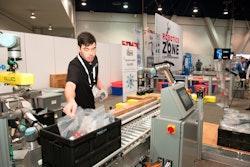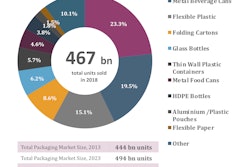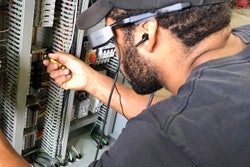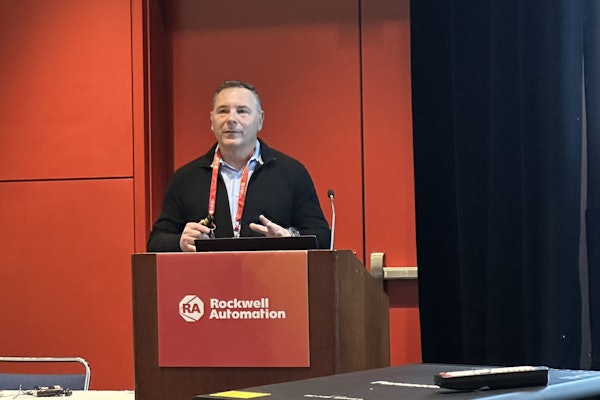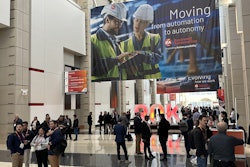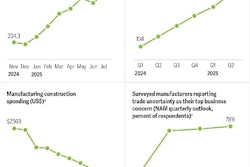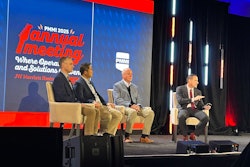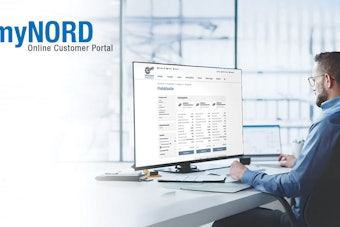Tronrud Engineering, a Norwegian machine builder, faces the same problems as every other OEM in the world—its customers want more flexibility in the machine, and they want the equipment delivered faster and cheaper. But what sets Tronrud apart from other OEMs is that it has actually found a way to do all that.
In fact, the release of its latest packaging machine for the food industry, which can pack 300 flow-wrap bags per minute into boxes, was designed in 10% less time than usual and the company reduced the commissioning phase by 25%.
The secret to their success is twofold. First, it’s a group effort. “The main difference is in the way we work together,” says Erik Hjertaas, general manager packaging technology at Tronrud Engineering, who was speaking during the unveiling of the new high-speed TCP PN12 packaging machine at Hannover Messe 2019. “Historically, mechanical designers are in one part of the business and software engineers are in the other waiting for the designs to be ready. We put them together and everyone puts data into the same 3D model to cut the time-to-market. We work better together.”
But all of this chumminess wouldn’t be possible without the help of technology—the second part of the success story. Specifically, a combination of 3D computer-aided design (CAD) and simulation software that creates a digital twin of the machine.
A digital twin is a virtual model of a physical product or process. In manufacturing, a digital twin can be a dynamic virtual representation of an entire plant, or it can be focused on a single asset, like a machine.
At Tronrud, they were building a new packaging machine that works at twice the speed of the current model and can handle rapid product changeovers—all in the same footprint. The machine was evolving from pneumatic to full electric operation, and that meant that there would be fundamental changes in the way the machine needed to be designed in order to deliver a fast, compact system that can handle different types of packaging.
And, of course, it had to be fully tested—which Tronrud did with a digital model using Siemens technology, including NX Mechatronics Concept Designer (MCD), a multi-discipline integrated system engineering software, Simatic S7-PLCSIM Advanced, which enables realistic simulations of controllers without the real hardware, and the Totally Integrated Automation (TIA) Portal, a digital framework for mechanical and electrical design and automation engineering to test and identify failures before real commissioning takes place.
Testing machine functionality on a digital twin is a dramatic change from the way most OEMs test the design of a machine, which is by building a physical model of it. But when something fails on a physical prototype, it is a very expensive error.
“Error-related cost will increase by a factor of 10 as you go from one value-added level to the next,” says Colm Gavin, digitalization sales specialist, factory automation at Siemens, who was speaking about the digital twin during an Innovation Stage presentation at PACK EXPO Las Vegas. “But if you are sitting at a desk [working] in CAD and you find a mistake, it is cheap to fix it quickly.”
In addition, the Siemens technology takes simulation a step further by tying it to the automation system which may include virtual programmable logic controllers (PLCs) and human-machine interfaces (HMIs), thereby allowing the engineer to emulate how a machine will react in a variety of circumstances. And, the real advantage here, Gavin says, is a communication application programming interface (API) within TIA Portal that guarantees synchronous communication between the model and the PLC in order to simulate everything within the model, including programming and debugging.
“Many people will say a [virtual] PLC doesn’t do it, but in our case, we download a one-to-one match of what will go into the real PLC later,” Gavin says. “You are not forced into using the real hardware connected to the modeling software.”
For machine builders, this means there is more flexibility in the design and commissioning of products because the digital twin provides a riskless way to test different designs.
“Innovation is painful because the only way to learn is to fail,” Hjertaas says. “By introducing this virtual model, a digital twin of our machine, we can do all of our failing faster and do it virtually, which is cheaper. By putting data into the same model, we can learn from that and see things we need to improve on prior to building the machine.”
These are the digital days
Technology is heading in a highly-automated direction. To that end, there’s a phenomenon that Gartner is calling “hyperautomation,” which the firm rates as number one on the “Gartner Top 10 Strategic Technology Trends for 2020” report. According to the research and advisory company, hyperautomation deals with the application of advanced technologies, including artificial intelligence (AI) and machine learning (ML) to increasingly automate processes and augment humans. It’s a combination of tools that, while not the main goal, will often result in the creation of a digital twin of the organization (DTO), propelling real-time, continuous intelligence about the organization and driving new business opportunities.
For OEMs, hyperautomation is coming in the form of model-based machine development. And the technology suppliers are stepping up with new offerings that they think will drive widespread adoption.
This past August, B&R Industrial Automation announced that it has integrated the industrialPhysics 3D simulation tool into its Automation Studio engineering environment. This will enable developers to import CAD data from machine components to entire machines directly into the simulation tools to generate a digital twin for developing and testing the machine. Because the simulation tool is integrated with Automation Studio, developers are able to run the virtual model of the machine right on the PC and connect with the controller. This makes it possible to view the physical behavior of the machine in real time, such as simulating the flow of materials through a line to identify potential collisions, which can be fixed in the digital model.
B&R has many variations of simulation tools in its product portfolio, all with the goal of shortening design cycles to accelerate time-to-market. A partnership with Maplesoft, for example, has resulted in the B&R MapleSim connector, which creates a simplified workflow between the system-level modeling environment (MapleSim) and the automation design environment (B&R Automation Studio). This connector allows designers to create their digital models and test their PLC code in the same workflow.
“Now you can play in a virtual sandbox environment where mistakes are free,” says Derrick Stacey, product owner, portfolio management at B&R. “Which is nice when you are trying to be innovative.”
B&R knows a little something about innovation with its development of ACOPOStrak, an intelligent track system that uses independently controlled shuttles and electromagnetic diverters to divide and merge product flows at full production speed. In an effort to prove out the technology to OEMs and end users, B&R is using digital twin technology to configure and reconfigure adaptive machines—ensuring the equipment meets customer requirements right away.
B&R uses simulation to show people what track systems can do. And, in fact, Stacey has been able to demonstrate to customers that they are putting in too many shuttles for the application, for example, and therefore not only saving them money and space, but providing them with a full understanding of what they are getting before committing to a purchase order.
In fact, the integration of industrialPhysics simulation into its Automation Studio makes it possible to view the ACOPOStrak digital twin using virtual reality or augmented reality headsets. With virtual reality, processes can be evaluated with simulation running, and with augmented reality, the OEM or end user is able to view the model on-site in the real environment
“With the digital twin, seeing is believing, which helps open a lot of doors as far as questions and answers go, and the back and forth between the supplier and the OEM,” Stacey says.
Siemens’ Gavin agrees that simulation—even on a virtual HMI—can change the understanding of how the machine will run, which could even influence the sales process. “How does an OEM sell a machine today? A photograph? If you take a digital twin to customer and show them what it will do, they can get a better understanding of what they will get and if it works with their requirements.”
Commissioning the latest creation
It’s during the deployment of a machine when most of the controller programming is done, getting tweaked and modified to meet unforeseen circumstances on the plant floor. Understanding this is a major pain point in equipment commissioning, Rockwell Automation, too, made a move toward digital twin technology.
Last January, Rockwell acquired Emulate3D, a UK-based developer of simulating and emulating software for industrial automation systems. A sweet spot for the company is material handling in packaging. For OEMs, the product Emulate3D Controls Testing for Machine Builders helps create controls testing models on a wide range of machine types, directly within Dassault Systemes SolidWorks 3D design software. The tool allows users to design the machines or mechanical system in CAD, mark up the kinematic and control elements, add a load source if the operation is triggered by the presence of products, then connect the control and activation elements to the PLC I/O and run the emulation model.
According to the company, by combining mechanical CAD information with real control system logic, you can create a valuable testbed in the form of a dynamic digital twin. This changes design and commissioning from a linear path to a parallel approach. “As soon as the system is designed you can start developing and testing the control system,” says Ian McGregor, business development manager at Emulate3D by Rockwell Automation.
The tool is based on a precise mathematical model, and a capability the company calls Aspects adds functionality to the CAD model. Aspects are properties which inform the runtime environment of the behaviors associated with the CAD element. Aspects associated with material handling models, for example, might include collision geometry physics types such as box, mesh, sphere, cylinder, etc., kinematic joints such as hinge, slider, etc., or movement surfaces like conveyors.
“When you mark something up in a particular way, we can look at other things marked up and make algorithmic decisions of how it will all work,” McGregor says.
The future is now
Making a digital twin of a machine may seem like a reach for many OEMs—and perhaps even not necessary. But as the digital trajectory continues across the enterprise and plant, manufacturers will soon be demanding that OEMs supply a digital twin as part of a standard order. So, now is the time to get ahead of it and start on a small scale to understand the workflow, the technology suppliers say.
“A digital twin is something many end users are thinking about, but not something the machine builders are doing yet,” says John Kowal, director of business development at B&R. But it is something OEMs will have to consider. “Just like when the industry went through lean manufacturing or vendor managed inventory, this is another tool to be more efficient and to differentiate your company in the marketplace.”
Siemens’ Gavin echoes that thought: “End users will start expecting digital twins from their machine builders, and the ones behind on this will be left behind for sure.”
And once an OEM starts using the digital twin, it opens up new opportunities—think innovative R&D, virtual factory acceptance tests (FAT), asset lifecycle management, and end user training. And it also becomes integral to the digital enterprise. At Tronrud, the digital twin is now a part of the way they do business.
“I see the digital twin as a natural part of our everyday work,” says Hjertaas. “We put data from real life models back into the virtual model to simulate things that could happen in operations, so we have to use this every day, and we will continue to. We can’t predict the future, but when there is data available from a machine digitally, we can use that to make the machines even better.”
For more on digital twin technology, read "Digital Twin Makes Virtual Commissioning a Reality" in Automation World.


